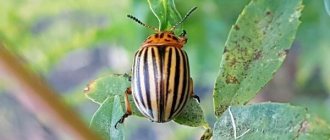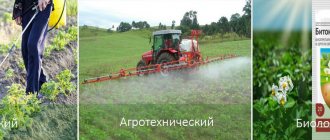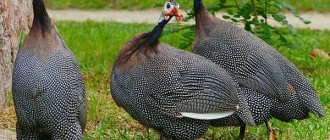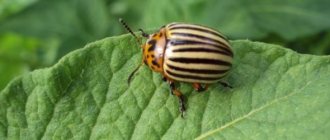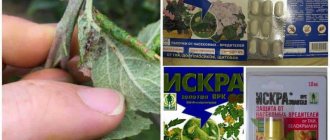Where did the Colorado potato beetle come from? How and when did the Colorado potato beetle appear in Russia?
There are several versions of where the Colorado potato beetle came from in Russia. One of them is the deliberate spread of the pest by the American CIA services during the Cold War between the USSR and the USA. When the Colorado potato beetle appeared in Russia, experts do not give an exact answer, but indicate the approximate years of infestation of our territory.
Pest migration
The homeland of the Colorado potato beetle is warm, sunny Mexico. For the first time, rural residents discovered a striped creature with a huge appetite in 1824. Initially, the insect ate tomatoes, bell peppers, eggplants, petunia leaves, and tobacco. With the active appearance of potatoes in the fields, Colorado moved to this crop. However, the story of the Colorado potato beetle does not end there, but is just beginning.
In 1959, the parasite caused enormous damage to potatoes in several states of Colorado in America. This is where the name came from. With the spread of shipping and active trade in potatoes, the insect began to colonize other continents. During the First World War, a massive appearance was discovered in France. American military bases were located in this country, where food and food supplies from the United States were transported to soldiers. Migration across Europe began from the French town of Bordeaux.
The appearance of a pest in the USSR
Colorado beetle
In what year the Colorado potato beetle was brought to Russia, there is no exact information. Presumably they began to import during the Second World War - 1943-1949. Some experts call the moment of settlement the beginning of hostilities, others - the end.
In 1949, a striped insect was discovered on the territory of Ukraine. The dry, hot summer of 1953 contributed to the resettlement throughout Ukraine, the Baltic states, and Belarus. Who brought the Colorado potato beetle to Russia is a question that interests many, since the insect’s large-scale sabotage resembles sabotage.
DDT is not a problem
However, let's return to the mainland. So, taking advantage of two wars, I managed to capture more than vast territories of Europe, Siberia and the Far East. I didn’t go far to the south - it’s too hot there. In the north, as you understand, it is a little cold, and the path to the east for me ended on the shores of Japan. Were people trying to stop expansion or even destroy me? Without a doubt. In the USA they successfully (as it seemed to the Americans themselves) fought against me. True, their entire struggle came down to hundreds of tons of DDT (pesticide) and other nasty things that were sprayed over the fields and then consumed as food by the people themselves. By the way, a note to those who like to indulge in pesticides: I very quickly adapt to almost any type of poison. The Europeans began by looking for my natural enemies in nature. Where do you think they started their search? In Colorado, of course! Someone please explain to me human logic: first they themselves, without asking anyone, call me the Colorado potato beetle, and then they claim that I was born in Colorado - miracles!
Colorado potato beetle eggs. Description of the Colorado potato beetle
Let us remind you what an adult beetle looks like: large, 8–12 mm with a convex body, shiny elytra with yellow and black stripes. The Colorado potato beetle has wings and easily moves over long distances.
Female beetles lay eggs primarily on the underside of leaves. The egg laying is bright yellow or orange, it is impossible to tear it off from the leaves (shake it off), there are 40 - 60 eggs in one clutch. Over the summer, one female lays an average of 350 - 400 eggs; in central Russia there is one generation of pests per summer, in the southern regions at least two.
Colorado potato beetle eggs develop on average 5 – 12 days, depending on the temperature (the hotter, the faster). The larvae are brick-colored with a black head, grow very quickly, have several periods of development (1st and 2nd instar), but the average gardener is not interested in these zoological subtleties - larvae of any age devour leaves, only at different rates - the larger, the more intense .
If the temperature is unfavorable, the larvae go to pupate - they burrow in the upper layers of the soil, turn into a pupa and go into suspended animation until spring, or if it is still warm, 2 - 3 weeks after pupation, the beetles crawl to the surface to further destroy our crop.
There is a peculiarity in the life cycle of Colorado potato beetles: in addition to the winter diapause, there is a summer dormant period, which occurs during the hottest time and lasts on average 8–10 days and is manifested in the pronounced passivity of the pest. This even gives some summer residents hope and relaxes them to a certain extent. But be on the lookout, waking up from the heat, the beetles bite into the potato tops with renewed vigor. Attention: if there is no extreme heat, Colorados do not have any diapause!
Appearance and features
Photo: Colorado potato beetle in nature
The Colorado potato beetle is a fairly large insect. Adults can grow up to 8 - 12 mm in length and approximately 7 mm in width. The body shape of the beetles is somewhat reminiscent of a water drop: oblong, flat at the bottom and convex at the top. An adult beetle can weigh 140-160 mg.
The surface of the beetle's body is hard and slightly shiny. In this case, the back is yellowish-black with black longitudinal stripes, and the belly is light orange. The beetle's black oblong eyes are located on the sides of its round and wide head. On the head of the beetle there is a black spot similar to a triangle, as well as movable, articulated antennae, consisting of 11 parts.
The hard and fairly durable elytra of the potato beetle fit tightly to the body and usually have a yellowish-orange, less often yellow, color, with longitudinal stripes. The wings of the Colorado potato beetle are membranous, well developed, and very strong, which allows the beetle to travel long distances in search of sources of food. Female beetles are usually slightly smaller than males and do not differ from them in any other way in appearance.
Colorado potato beetle habitat. Where do Colorado potato beetles live? Their habitat
The homeland of the Colorado potato beetle is Mexico, namely the Sonoran subregion. The first serious damage to potato plantings by the Colorado potato beetle was noted in Nebraska in 1855.
It got its name from an event that occurred in 1859 in Colorado. This year, insects have devastated large areas of potato crops in the state. But there is another theory for the appearance of this name: from the Mexican language the word “colorado” is translated as “colored,” which suits the motley appearance of the pest.
The beetle quickly spread across North America. Later, in 1876-1877, it came to the Western part of Europe on potato tubers brought from abroad. In general, at that time there was no critical situation with Colorado potato beetles, since all foci of their occurrence were destroyed. But everything changed in 1918, during the First World War, the beetle managed to reproduce in France, in the Bordeaux region.
During the Great Patriotic War, pests were already at the borders of the USSR.
For the first time on the territory of the former USSR, beetles were noticed in 1949 in the Lvov region; in 1953, they began to be found in the Kaliningrad, Volyn, Grodno and Brest regions. In 1958, during the hot and windy months, a massive influx of Colorado beetles into the Transcarpathian region and Poland occurred from Hungary and Czechoslovakia.
Gradually, the insects moved deep into Russia, where there were huge potato crops, they began to multiply incredibly quickly and spread throughout the country. Since the mid-1970s, beetles have been spotted in the Southern Urals, and in 2000 - already in the Primorsky Territory.
The Colorado potato beetle's habitat is nightshade crops; it can be found in any open areas. These pests can be found almost everywhere, with the exception of the Far North and desert areas.
Adult beetles accumulate fat reserves, due to which they are able to carry out long-distance flights. If there is a strong wind at this time, the insects can quickly fly away tens of kilometers from the place where they hatch from the eggs.
Life of a Bug
The life cycle of the Colorado potato beetle is simple and at the same time effective. Only adult individuals (imago) overwinter, burrowing 20-50 cm into the ground. Mating usually occurs in the spring, but can also happen in the fall, before diapause (winter dormancy), and just one fertilized female is enough for a new focus of the pest to arise.
One female is capable of laying up to 1000 eggs, although the average figure is three times less. The dynamics depend on the weather, and the beetle develops especially rapidly in hot, dry summers. In the northern part of the range, 1 generation is usually hatched, in the southern part - 2-3.
Mating usually occurs in the spring, but can also occur in the fall
Females lay eggs on the underside of the leaf and therefore, although the clutches are bright yellow-orange, they are difficult to notice. After 5-17 days the larvae appear. They have 4 instars, based on the number of moults.
Typically, the larvae of the first and second instars stay together - in “red clusters” on the tops of the shoots, and the third and fourth instars spread across neighboring bushes. 2-3 weeks after hatching from the egg, the larvae go into the ground to a depth of about 10 cm and pupate. The pupal stage lasts 10-20 days.
Red clusters of larvae
Depending on the weather and soil temperature, an adult may emerge to the surface and continue its harmful activities or gradually hibernate until next spring. Typically, a mature beetle lives for 1 year, but in the population there is always a part of individuals capable of long-term diapause - up to 2-3 years, which makes pest control difficult.
Colorado beetle drawing. Origin of the species and description
Photo: Colorado potato beetle
The Colorado potato beetle was first discovered and described in detail by American entomologist Thomas Sayem. This happened back in 1824. The scientist collected several specimens of a beetle hitherto unknown to science in the southwestern United States.
The name “Colorado beetle” appeared later - in 1859, when an invasion of these insects destroyed entire potato fields in Colorado (USA). After a couple of decades, there were so many beetles in this state that most local farmers were forced to give up growing potatoes, despite the fact that their price had increased significantly.
Gradually, year after year, in the holds of sea ships that were loaded with potato tubers, the beetle crossed the Atlantic Ocean and ended up in Europe. In 1876 it was discovered in Leipzig, and after another 30 years, the Colorado potato beetle could be found throughout Western Europe except Great Britain.
Until 1918, the breeding grounds of the Colorado potato beetle could be successfully destroyed, until it managed to settle in France (Bordeaux region). Apparently the climate of Bordeaux was ideal for the pest, as it began to rapidly multiply there and literally spread throughout Western Europe and beyond.
Interesting fact: Due to the peculiarities of its structure, the Colorado potato beetle cannot drown in water, so even large bodies of water are not a serious obstacle for it in its search for food.
The beetle allegedly entered the territory of the USSR in 1940, and after another 15 years it was already found everywhere in the western part of the Ukrainian SSR (Ukraine) and the BSSR (Belarus). In 1975, the Colorado potato beetle reached the Urals. The reason for this was a long, abnormal drought, due to which livestock feed (hay, straw) was brought to the Urals from Ukraine. Apparently, a pest beetle also came here along with the straw.
It turns out that in the USSR and other countries of the socialist camp, the mass spread of the beetle coincided with the beginning of the so-called “Cold War”, so accusations of an unexpected disaster were addressed to the American intelligence service CIA. Polish and German newspapers even at this time wrote that the beetle was deliberately thrown into the territory of the GDR and Poland by American aircraft.
Fighting bugs
From the moment the Colorado potato beetle appeared in our country, it has shown amazing resistance to all possible poisons, tolerates temperature changes well, and is not afraid of serious weather disasters. The fight against them in Russia and in the world never stops, but it can never be completely completed. Since the late 50s, attempts have been made in the USSR to destroy the pest. Various quarantine measures and potato processing were carried out. But in most cases, the result is only seasonal, and even then with varying success.
With the development of science, the fight against beetles has reached a new level. Now there are even genetically modified varieties of potatoes, which with their composition can kill beetles that have tasted their favorite product. But, as it turned out, even this serious step did not bring the desired result - the insect quickly adapts to all poisons and substances dangerous to it and they no longer pose a danger to it.
In conclusion, it is worth saying that the Colorado potato beetle appeared in Russia, as well as in Europe, relatively recently, but it settled thoroughly and, apparently, for a long time.
Colorado potato beetle who eats it. Who eats the Colorado potato beetle? The main natural enemies of the pest
Who eats the Colorado potato beetle? In domestic latitudes there are birds and insects that act as natural enemies of this pest. For example, it is known for sure that guinea fowl eat Colorado potato beetles.
In the southern regions of the planet there are many more animals that can help in destroying the parasitic insect. However, we will not talk about this in this material, since their use in our conditions seems impossible. Let's look at who eats the Colorado potato beetle in the current climatic conditions.
Ladybug
One of the main natural enemies of the pest is the ladybug. The insect is effective only if it is necessary to exterminate the Colorado potato beetle in its early stages of development. In other words, the ladybug is capable of eating exclusively small larvae and eggs of the potato parasite.
Lacewing
If we talk about who eats the Colorado potato beetle among insect representatives, we cannot ignore the lacewing. In appearance, it resembles a small dragonfly of a light green color.
The lacewing is a predator. The insect is known for its gluttony and unpretentiousness in choosing food. The lacewing can help in destroying clutches of eggs and recently hatched larvae of the Colorado potato beetle. Due to its modest size, it is not able to influence adult, mature pests.
Syrphids
The insects known locally as hoverflies are predatory flies. Like ladybugs and lacewings, syrphids are one of the main natural enemies of this pest.
Hoverflies do not reach the size of an adult Colorado potato beetle. Therefore, they are absolutely useless in the fight against large individuals. However, their spread on a plot of land during the formation of pest larvae can significantly reduce its population.
Guinea fowl
What bird eats the Colorado potato beetle? They have proven themselves to be an effective exterminator of the guinea fowl parasite. These small birds eat insects well, which have a bright protective color. Guinea fowl not only peck larvae and clutches of eggs from potato shoots, but also pick up adult individuals from the ground and rake the soil with their paws in search of buried pests.
Pheasant
Who eats the Colorado potato beetle among other poultry? Pheasants cope well with this task. For these purposes, they are walked around the plot in the first half of summer. It was at this time that a massive increase in the parasite population was observed.
Breeding pheasants makes it possible to cope with the extermination of a number of other harmful insects, in particular, the larvae of the cockchafer and the mole cricket. At the same time, these birds are quite picky about their living conditions and do not always survive in harsh domestic winters.
What other birds eat the Colorado potato beetle?
In addition to the above-mentioned poultry, the following can influence the reduction of the pest population to a certain extent:
- crows;
- cuckoos;
- starlings;
- hazel grouse;
- sparrows
Is it possible to use domestic chickens to kill pests?
As practice shows, it is quite possible to train chickens to eat the Colorado potato beetle.
Such poultry will peck larvae and adults from potato sheets only after preliminary “training”. It is necessary to accustom chickens to eat insects from an early age, when chickens reach 3-4 months. During this period, the bird’s favorite food should be mixed with Colorado potato beetle larvae. Thus, the chickens will have not only a visual, but also a taste association of the pest with the food. Subsequently, the prepared chickens will independently move around the beds, pecking parasites from the tops.
Finally
The advantages of exterminating the Colorado potato beetle without the use of chemicals are simply obvious. The gardener does not have to spend precious time, effort and money on cultivating the plot. In addition, such methods do not pose a risk to human health.
As for the disadvantages of the above methods, it is worth noting their rather low efficiency. Even a large number of birds will not be able to completely exterminate the pest population.
Colorado potato beetle larva and its weaknesses
Despite the fact that today there are dozens or even hundreds of different ways to get rid of the above insects, folk remedies are still quite popular. They are also characterized by their diversity. The most important thing is that each person has the opportunity to choose the most optimal way to combat the Colorado potato beetle for a particular case.
A very effective method is to plant sprouted tubers. This must be done in early spring immediately after the bud ripens.
You can also place bait on its surface in the form of cut potatoes, which will definitely attract the attention of pests. Once the beetles gather on these baits, they can be destroyed quite simply
First of all, this concerns larvae, because without using traps it is quite difficult to determine how many of them are in the garden at one time or another.
After the future potato crop has sprouted for the first time, it must be covered with soil. This method of combating the Colorado potato beetle is also quite effective. It is best to use it around May-June. Manual collection of larvae will help if the expected harvest is far from the most impressive.
Biological control method
Practice shows that due to the correct use of this method, the larva of the Colorado potato beetle is not capable of further development and dies before the moment when it turns into a full-fledged adult. The main advantage of the biological method is that it is absolutely incapable of disturbing the ecological balance in plants and soil. In parallel with the destruction of pests, the environment is not contaminated with toxic substances, which is a very important factor for most citizens.
One of the most common biological methods of controlling Colorado potato beetles is the activation of beneficial entomofauna. In this case, you can use special preparations that were produced on the basis of very active strains of fungi and bacteria. The subsequent use of a variety of preventive methods, which absolutely do not include chemicals, allows you to protect your own vegetable crops from parasites for a long time.
Reasons for the survivability of the Colorado potato beetle
Many have noticed that the presented insect, as well as its larvae in our area, are able to tolerate the effects of a wide variety of drugs and continue to harm vegetables. In fact, this is due to a number of objective factors. Each larva of the Colorado potato beetle gets a unique opportunity to develop calmly, because it has virtually no natural enemies. The same situation is almost impossible to imagine, for example, overseas, where these insects are constantly forced to fight for their existence.
Among other things, the Colorado potato beetle has the unique ability to enter a fairly long diapause, which can last up to three years. Thanks to this opinion, this parasite survives the most difficult years of its existence without any problems, when there is a lack of food variety. After diapause is completed, the pest is still able to produce one hundred percent healthy offspring. In the winter season, it is completely useless to fight this insect. Due to the fact that Colorado potato beetles lie quite deep in the soil during this period, even strong chemicals are not capable of causing significant harm to them. If there are no beetles in the garden at a certain moment, then you should not relax too seriously. These parasites are capable of flying over distances of tens of kilometers, which is why they can settle in a new area at any time.
